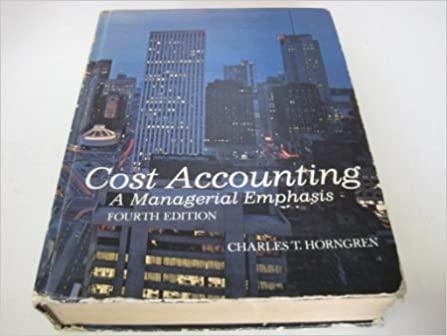Transfer Pricing in Banks The Jackson Stone National Bank is a two-branch bank servicing retail and wholesale
Question:
Transfer Pricing in Banks The Jackson Stone National Bank is a two-branch bank servicing retail and wholesale customers in the greater Big City metropolitan area. The head-office staff consists of the president and the controller.
With minor exceptions, the branch managers are permitted to conduct their affairs like the heads of two independent banks. The planning and control system centers around branch income statements prepared by the controller.
The Big City branch, located in the growing downtown area, serves primarily commercial customers. The manager, Mr. Jones, has found in recent years that while he faces a number of vigorous competitors, the principal constraint on his ability to generate new loan business is a lack of supporting deposits. The only alternative source of lendable funds is the purchase of Eurodollars, which are dollar deposits held in a bank outside the United States.
This option is considered less than acceptable by Jones, as the 11 percent interest he would have to pay for such funds is higher than the rate he is able to charge loan customers, currently 10 percent.
The new Sun City branch, on the other hand, is located outside of town in a large and growing retirement community and is primarily a retail branch.
Mr. Smith, the manager, is in his first year with the Stone Bank. In his attempts to sell the bank’s services to the Sun City residents, he has found that his only success is in the area of savings deposits. Loan business, on the other hand, is both competitive and scarce. The interest rate he can charge is constrained by the fact that the manager of the local branch of the Behemoth Bank, while not actively soliciting loan business, is apparently charging rates below the prevailing Big City prime rate. Additionally, there seems to be a fundamental resistance on the part of the Sun City residents to the idea of borrowing, even at the 6 percent rates Smith has been offering. In spite of his frequent lectures on the merits of leverage, the best Smith has been able to do is to generate a few golf-cart installment and Social Security check receivable loans. As a result, he finds himself with substantial excess savings deposits on which he is paying 5 percent interest but earning nothing. Aside from the deposits, which he has to keep in the vault to satisfy the government’s 20 percent (of deposits) reserve requirement, the vault additionally contains excess lendable funds equal to almost 70 percent of total savings deposits.
The controller has suggested that he lend these funds to Jones at the Big City branch. This was acceptable’to both managers, although some disagreement arose as to the interest rate appropriate for such a loan. The argument was finally settled by the controller, who indicated that the theoretically correct rate was the rate Smith was paying on savings deposits, 5 percent. It has been further agreed that if Smith could find additional loans, any or all of the funds lent to Jones would be returned.
Evaluate the 5 percent interbranch loan rate, and suggest appropriate changes in relation to the following criteria:
a. Motivating managers to act in a manner consistent with the best interests of the bank as a whole.
b. Evaluating the performance of individual branches.
. Would your answer change if the Sun City loan rate were to rise to 7 percent, while all other rates, as well as the level of loan demand at Sun City, remained the same?
- Would your answer change if all rates were the same as in part 1, except that the cost of Eurodollars dropped to 9 percent?
. Based on your answers to the questions above, what general statements can you make about the interbranch loan rate appropriate for evaluating indi- vidual managers? lop1
Step by Step Answer:






